University Corporate Accounting and Reporting - Impairment Loss Report
VerifiedAdded on 2021/06/15
|10
|1937
|26
Report
AI Summary
This comprehensive report examines the concept of impairment loss within corporate accounting, with a specific focus on cash-generating units (CGUs) excluding goodwill. It provides a thorough overview of IAS 36, the accounting standard governing impairment, and discusses the methods for assessing impairment, including the calculation of value in use and fair value less costs of disposal. The report details the allocation of impairment losses, first to goodwill and then to other assets, along with the procedures for reversing impairment losses. It includes a practical case study of Gali Limited, illustrating the application of impairment assessment and the journal entries required to record the impairment loss. The report also covers disclosure requirements for financial statements regarding impairment, ensuring a complete understanding of the topic. The report also contains detailed analysis on the impairment assessment of the Gali Limited for the year ended 30th June 2015, including the journal entries to give effect to the above transaction in the books.
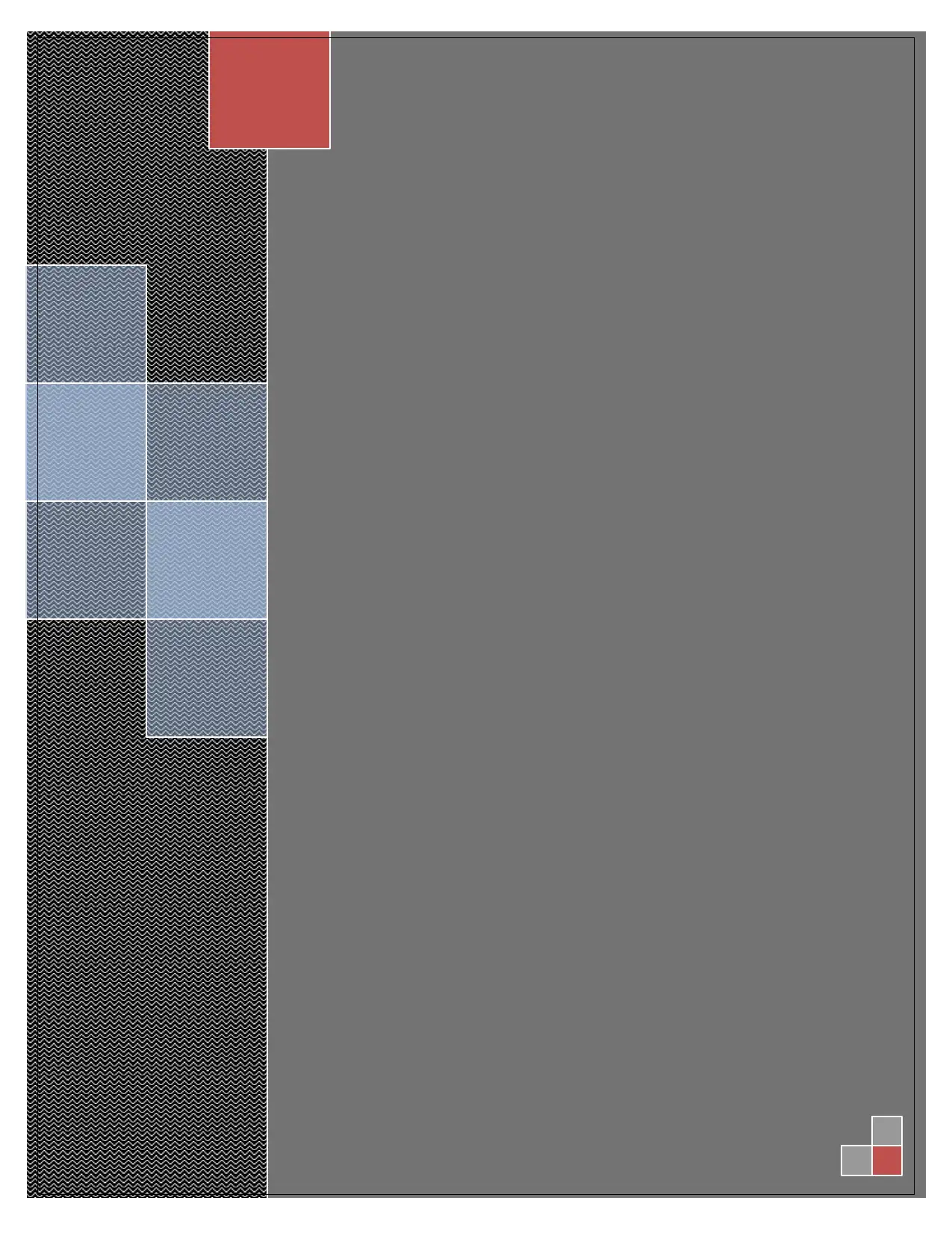
Paraphrase This Document
Need a fresh take? Get an instant paraphrase of this document with our AI Paraphraser
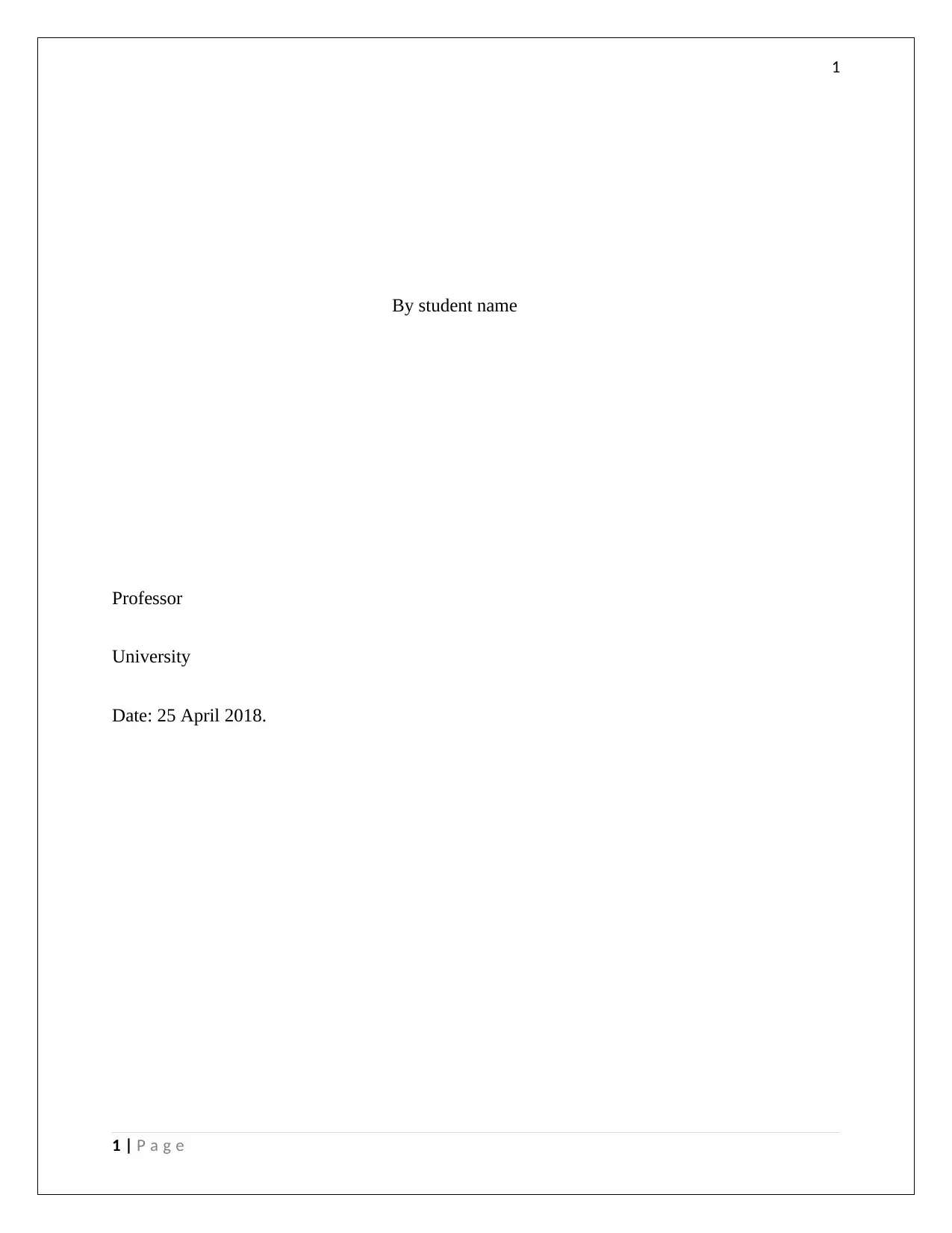
1
By student name
Professor
University
Date: 25 April 2018.
1 | P a g e
By student name
Professor
University
Date: 25 April 2018.
1 | P a g e

2
Executive Summary
The report has been prepared on the topic of impairment loss of the cash-generating unit
excluding Goodwill. All the background and introduction on the topic “Impairment” has been
included in the given assignment along with the provision from IAS 36, which deals on
impairment. Specific discussion on the impairment and the goodwill and CGU has also been
covered. Finally, a sum has been solved in impairment to give the entire idea of impairment of
assets for the company Gali Limited for the year ended 30th June 2015 and impairment entries
have been given.
2 | P a g e
Executive Summary
The report has been prepared on the topic of impairment loss of the cash-generating unit
excluding Goodwill. All the background and introduction on the topic “Impairment” has been
included in the given assignment along with the provision from IAS 36, which deals on
impairment. Specific discussion on the impairment and the goodwill and CGU has also been
covered. Finally, a sum has been solved in impairment to give the entire idea of impairment of
assets for the company Gali Limited for the year ended 30th June 2015 and impairment entries
have been given.
2 | P a g e
⊘ This is a preview!⊘
Do you want full access?
Subscribe today to unlock all pages.

Trusted by 1+ million students worldwide

3
Contents
Background..................................................................................................................................................3
Partnership Deed – Features and Analysis..................................................................................................3
Conclusion...................................................................................................................................................4
References...................................................................................................................................................4
3 | P a g e
Contents
Background..................................................................................................................................................3
Partnership Deed – Features and Analysis..................................................................................................3
Conclusion...................................................................................................................................................4
References...................................................................................................................................................4
3 | P a g e
Paraphrase This Document
Need a fresh take? Get an instant paraphrase of this document with our AI Paraphraser
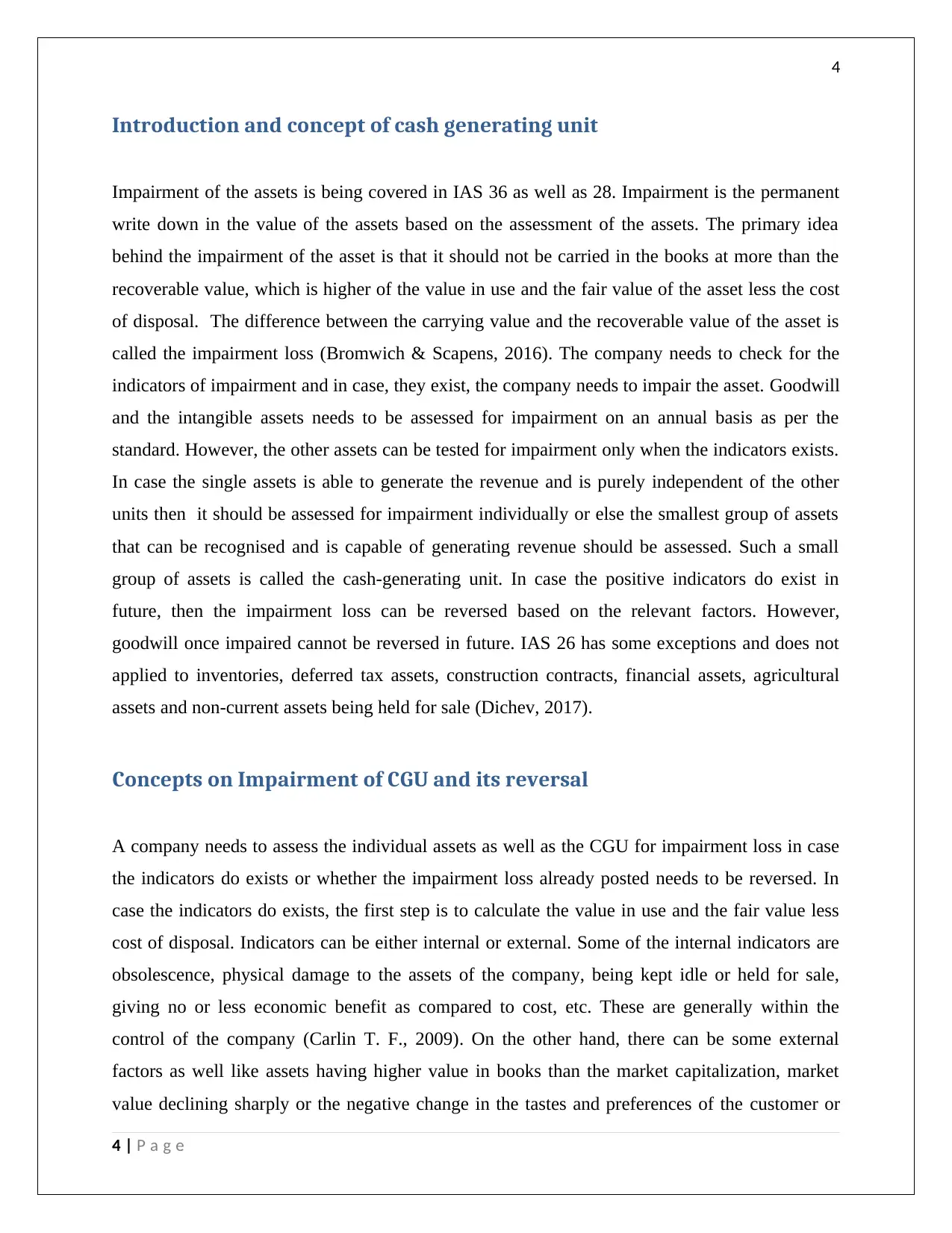
4
Introduction and concept of cash generating unit
Impairment of the assets is being covered in IAS 36 as well as 28. Impairment is the permanent
write down in the value of the assets based on the assessment of the assets. The primary idea
behind the impairment of the asset is that it should not be carried in the books at more than the
recoverable value, which is higher of the value in use and the fair value of the asset less the cost
of disposal. The difference between the carrying value and the recoverable value of the asset is
called the impairment loss (Bromwich & Scapens, 2016). The company needs to check for the
indicators of impairment and in case, they exist, the company needs to impair the asset. Goodwill
and the intangible assets needs to be assessed for impairment on an annual basis as per the
standard. However, the other assets can be tested for impairment only when the indicators exists.
In case the single assets is able to generate the revenue and is purely independent of the other
units then it should be assessed for impairment individually or else the smallest group of assets
that can be recognised and is capable of generating revenue should be assessed. Such a small
group of assets is called the cash-generating unit. In case the positive indicators do exist in
future, then the impairment loss can be reversed based on the relevant factors. However,
goodwill once impaired cannot be reversed in future. IAS 26 has some exceptions and does not
applied to inventories, deferred tax assets, construction contracts, financial assets, agricultural
assets and non-current assets being held for sale (Dichev, 2017).
Concepts on Impairment of CGU and its reversal
A company needs to assess the individual assets as well as the CGU for impairment loss in case
the indicators do exists or whether the impairment loss already posted needs to be reversed. In
case the indicators do exists, the first step is to calculate the value in use and the fair value less
cost of disposal. Indicators can be either internal or external. Some of the internal indicators are
obsolescence, physical damage to the assets of the company, being kept idle or held for sale,
giving no or less economic benefit as compared to cost, etc. These are generally within the
control of the company (Carlin T. F., 2009). On the other hand, there can be some external
factors as well like assets having higher value in books than the market capitalization, market
value declining sharply or the negative change in the tastes and preferences of the customer or
4 | P a g e
Introduction and concept of cash generating unit
Impairment of the assets is being covered in IAS 36 as well as 28. Impairment is the permanent
write down in the value of the assets based on the assessment of the assets. The primary idea
behind the impairment of the asset is that it should not be carried in the books at more than the
recoverable value, which is higher of the value in use and the fair value of the asset less the cost
of disposal. The difference between the carrying value and the recoverable value of the asset is
called the impairment loss (Bromwich & Scapens, 2016). The company needs to check for the
indicators of impairment and in case, they exist, the company needs to impair the asset. Goodwill
and the intangible assets needs to be assessed for impairment on an annual basis as per the
standard. However, the other assets can be tested for impairment only when the indicators exists.
In case the single assets is able to generate the revenue and is purely independent of the other
units then it should be assessed for impairment individually or else the smallest group of assets
that can be recognised and is capable of generating revenue should be assessed. Such a small
group of assets is called the cash-generating unit. In case the positive indicators do exist in
future, then the impairment loss can be reversed based on the relevant factors. However,
goodwill once impaired cannot be reversed in future. IAS 26 has some exceptions and does not
applied to inventories, deferred tax assets, construction contracts, financial assets, agricultural
assets and non-current assets being held for sale (Dichev, 2017).
Concepts on Impairment of CGU and its reversal
A company needs to assess the individual assets as well as the CGU for impairment loss in case
the indicators do exists or whether the impairment loss already posted needs to be reversed. In
case the indicators do exists, the first step is to calculate the value in use and the fair value less
cost of disposal. Indicators can be either internal or external. Some of the internal indicators are
obsolescence, physical damage to the assets of the company, being kept idle or held for sale,
giving no or less economic benefit as compared to cost, etc. These are generally within the
control of the company (Carlin T. F., 2009). On the other hand, there can be some external
factors as well like assets having higher value in books than the market capitalization, market
value declining sharply or the negative change in the tastes and preferences of the customer or
4 | P a g e

5
new technology being introduced in the market rendering the existing technology to be useless.
These factors are generally not in control of the entity and affect the entire industry or market.
This is just a sample list and not an exhaustive one. The company also needs to check on the
impairment methods, the estimated useful life and residual life of the asset towards the end of
each accounting year.
When the impairment of assets is being done, the first thing towards which the impairment loss
is allocated is the goodwill and then the remainder of the loss is being allocated to the other
assets. The next question is hand is how the impairment loss to be reversed is to be determined. It
is done in the same way as the impairment assessment is being done. Again if the positive factors
or indicators of impairment do exists, and the fair value less cost of disposal or the value in use is
more than the carrying value of the asset, then the impairment loss posted earlier to the profit and
loss account needs to be reversed and the remainder needs to be posted to the revaluation account
(Carlin T. a., 2011). In some cases, where the fair value cannot be determined, then the value in
use is taken as the recoverable value and the calculation is being done. The fair value of the asset
is to be determined in accordance with the fair value measurement under IFRS 13. The cost of
disposal includes all the allied and related costs. On the other hand, value in use is being
determined through use of variables like time value of money, the discounting factor, present
value of estimated future cash flows, ability of the asset to generate the cash flows and other
factors including the amount of uncertainty. The cash flows are being estimated based on the,
past recent or current data and the same is being extrapolated thereafter (Belton, 2017). The
interest rate, which should be used for discounting, should include the effect of the time value of
money and other market conditions. It should ideally be the rate that the investor would expect to
earn while investing in a particular market.
Conclusion and Disclosure requirements
Based on the all the inputs, it is clear that the difference between the recoverable value of the
CGU and the carrying value should be credited to the profit and loss account. Furthermore, the
future depreciation needs to be adjusted based on this on a prospective manner (Alexander,
2016). The carrying amount of the assets should not be reduced below zero and in case of CGU,
5 | P a g e
new technology being introduced in the market rendering the existing technology to be useless.
These factors are generally not in control of the entity and affect the entire industry or market.
This is just a sample list and not an exhaustive one. The company also needs to check on the
impairment methods, the estimated useful life and residual life of the asset towards the end of
each accounting year.
When the impairment of assets is being done, the first thing towards which the impairment loss
is allocated is the goodwill and then the remainder of the loss is being allocated to the other
assets. The next question is hand is how the impairment loss to be reversed is to be determined. It
is done in the same way as the impairment assessment is being done. Again if the positive factors
or indicators of impairment do exists, and the fair value less cost of disposal or the value in use is
more than the carrying value of the asset, then the impairment loss posted earlier to the profit and
loss account needs to be reversed and the remainder needs to be posted to the revaluation account
(Carlin T. a., 2011). In some cases, where the fair value cannot be determined, then the value in
use is taken as the recoverable value and the calculation is being done. The fair value of the asset
is to be determined in accordance with the fair value measurement under IFRS 13. The cost of
disposal includes all the allied and related costs. On the other hand, value in use is being
determined through use of variables like time value of money, the discounting factor, present
value of estimated future cash flows, ability of the asset to generate the cash flows and other
factors including the amount of uncertainty. The cash flows are being estimated based on the,
past recent or current data and the same is being extrapolated thereafter (Belton, 2017). The
interest rate, which should be used for discounting, should include the effect of the time value of
money and other market conditions. It should ideally be the rate that the investor would expect to
earn while investing in a particular market.
Conclusion and Disclosure requirements
Based on the all the inputs, it is clear that the difference between the recoverable value of the
CGU and the carrying value should be credited to the profit and loss account. Furthermore, the
future depreciation needs to be adjusted based on this on a prospective manner (Alexander,
2016). The carrying amount of the assets should not be reduced below zero and in case of CGU,
5 | P a g e
⊘ This is a preview!⊘
Do you want full access?
Subscribe today to unlock all pages.

Trusted by 1+ million students worldwide
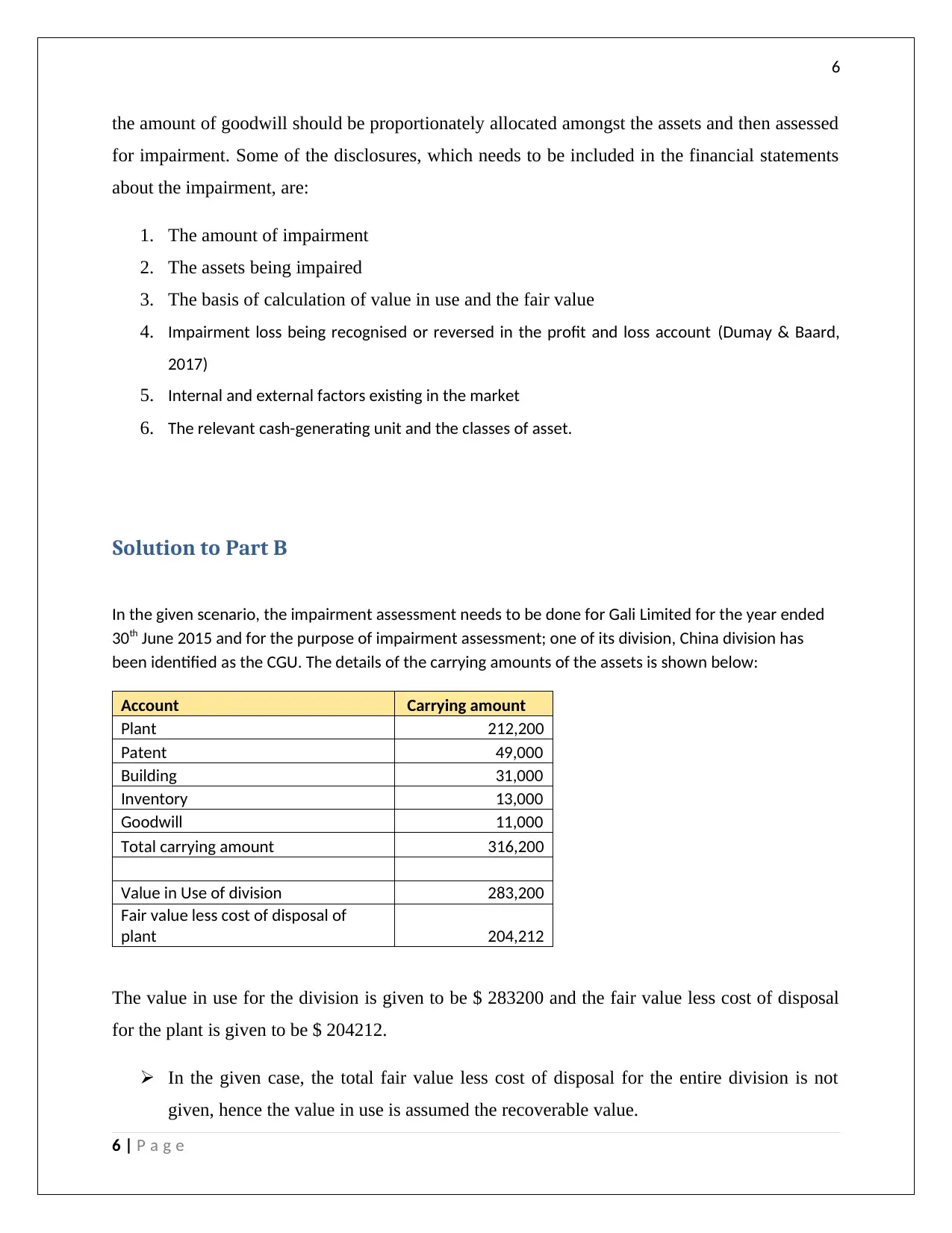
6
the amount of goodwill should be proportionately allocated amongst the assets and then assessed
for impairment. Some of the disclosures, which needs to be included in the financial statements
about the impairment, are:
1. The amount of impairment
2. The assets being impaired
3. The basis of calculation of value in use and the fair value
4. Impairment loss being recognised or reversed in the profit and loss account (Dumay & Baard,
2017)
5. Internal and external factors existing in the market
6. The relevant cash-generating unit and the classes of asset.
Solution to Part B
In the given scenario, the impairment assessment needs to be done for Gali Limited for the year ended
30th June 2015 and for the purpose of impairment assessment; one of its division, China division has
been identified as the CGU. The details of the carrying amounts of the assets is shown below:
Account Carrying amount
Plant 212,200
Patent 49,000
Building 31,000
Inventory 13,000
Goodwill 11,000
Total carrying amount 316,200
Value in Use of division 283,200
Fair value less cost of disposal of
plant 204,212
The value in use for the division is given to be $ 283200 and the fair value less cost of disposal
for the plant is given to be $ 204212.
In the given case, the total fair value less cost of disposal for the entire division is not
given, hence the value in use is assumed the recoverable value.
6 | P a g e
the amount of goodwill should be proportionately allocated amongst the assets and then assessed
for impairment. Some of the disclosures, which needs to be included in the financial statements
about the impairment, are:
1. The amount of impairment
2. The assets being impaired
3. The basis of calculation of value in use and the fair value
4. Impairment loss being recognised or reversed in the profit and loss account (Dumay & Baard,
2017)
5. Internal and external factors existing in the market
6. The relevant cash-generating unit and the classes of asset.
Solution to Part B
In the given scenario, the impairment assessment needs to be done for Gali Limited for the year ended
30th June 2015 and for the purpose of impairment assessment; one of its division, China division has
been identified as the CGU. The details of the carrying amounts of the assets is shown below:
Account Carrying amount
Plant 212,200
Patent 49,000
Building 31,000
Inventory 13,000
Goodwill 11,000
Total carrying amount 316,200
Value in Use of division 283,200
Fair value less cost of disposal of
plant 204,212
The value in use for the division is given to be $ 283200 and the fair value less cost of disposal
for the plant is given to be $ 204212.
In the given case, the total fair value less cost of disposal for the entire division is not
given, hence the value in use is assumed the recoverable value.
6 | P a g e
Paraphrase This Document
Need a fresh take? Get an instant paraphrase of this document with our AI Paraphraser
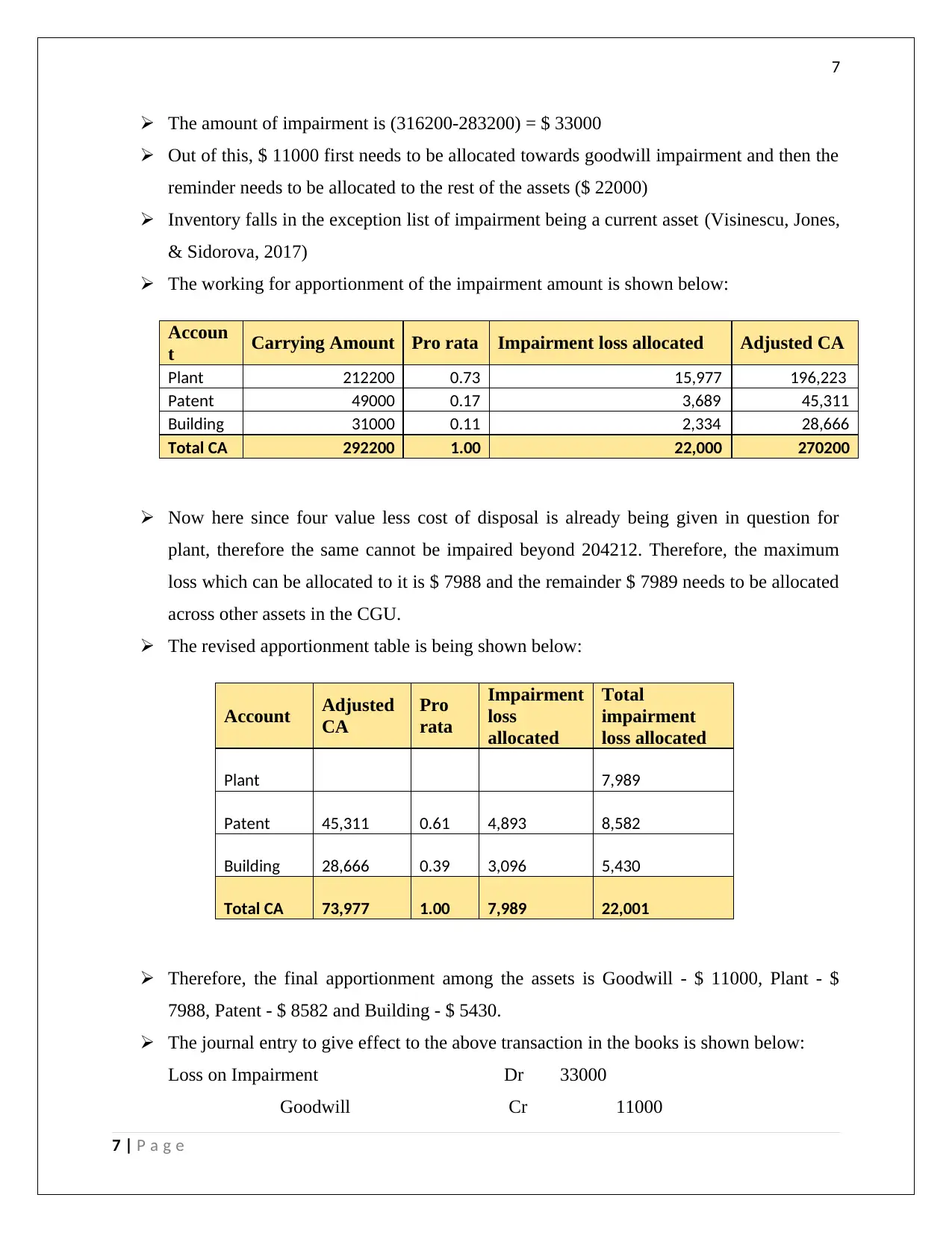
7
The amount of impairment is (316200-283200) = $ 33000
Out of this, $ 11000 first needs to be allocated towards goodwill impairment and then the
reminder needs to be allocated to the rest of the assets ($ 22000)
Inventory falls in the exception list of impairment being a current asset (Visinescu, Jones,
& Sidorova, 2017)
The working for apportionment of the impairment amount is shown below:
Accoun
t Carrying Amount Pro rata Impairment loss allocated Adjusted CA
Plant 212200 0.73 15,977 196,223
Patent 49000 0.17 3,689 45,311
Building 31000 0.11 2,334 28,666
Total CA 292200 1.00 22,000 270200
Now here since four value less cost of disposal is already being given in question for
plant, therefore the same cannot be impaired beyond 204212. Therefore, the maximum
loss which can be allocated to it is $ 7988 and the remainder $ 7989 needs to be allocated
across other assets in the CGU.
The revised apportionment table is being shown below:
Account Adjusted
CA
Pro
rata
Impairment
loss
allocated
Total
impairment
loss allocated
Plant 7,989
Patent 45,311 0.61 4,893 8,582
Building 28,666 0.39 3,096 5,430
Total CA 73,977 1.00 7,989 22,001
Therefore, the final apportionment among the assets is Goodwill - $ 11000, Plant - $
7988, Patent - $ 8582 and Building - $ 5430.
The journal entry to give effect to the above transaction in the books is shown below:
Loss on Impairment Dr 33000
Goodwill Cr 11000
7 | P a g e
The amount of impairment is (316200-283200) = $ 33000
Out of this, $ 11000 first needs to be allocated towards goodwill impairment and then the
reminder needs to be allocated to the rest of the assets ($ 22000)
Inventory falls in the exception list of impairment being a current asset (Visinescu, Jones,
& Sidorova, 2017)
The working for apportionment of the impairment amount is shown below:
Accoun
t Carrying Amount Pro rata Impairment loss allocated Adjusted CA
Plant 212200 0.73 15,977 196,223
Patent 49000 0.17 3,689 45,311
Building 31000 0.11 2,334 28,666
Total CA 292200 1.00 22,000 270200
Now here since four value less cost of disposal is already being given in question for
plant, therefore the same cannot be impaired beyond 204212. Therefore, the maximum
loss which can be allocated to it is $ 7988 and the remainder $ 7989 needs to be allocated
across other assets in the CGU.
The revised apportionment table is being shown below:
Account Adjusted
CA
Pro
rata
Impairment
loss
allocated
Total
impairment
loss allocated
Plant 7,989
Patent 45,311 0.61 4,893 8,582
Building 28,666 0.39 3,096 5,430
Total CA 73,977 1.00 7,989 22,001
Therefore, the final apportionment among the assets is Goodwill - $ 11000, Plant - $
7988, Patent - $ 8582 and Building - $ 5430.
The journal entry to give effect to the above transaction in the books is shown below:
Loss on Impairment Dr 33000
Goodwill Cr 11000
7 | P a g e
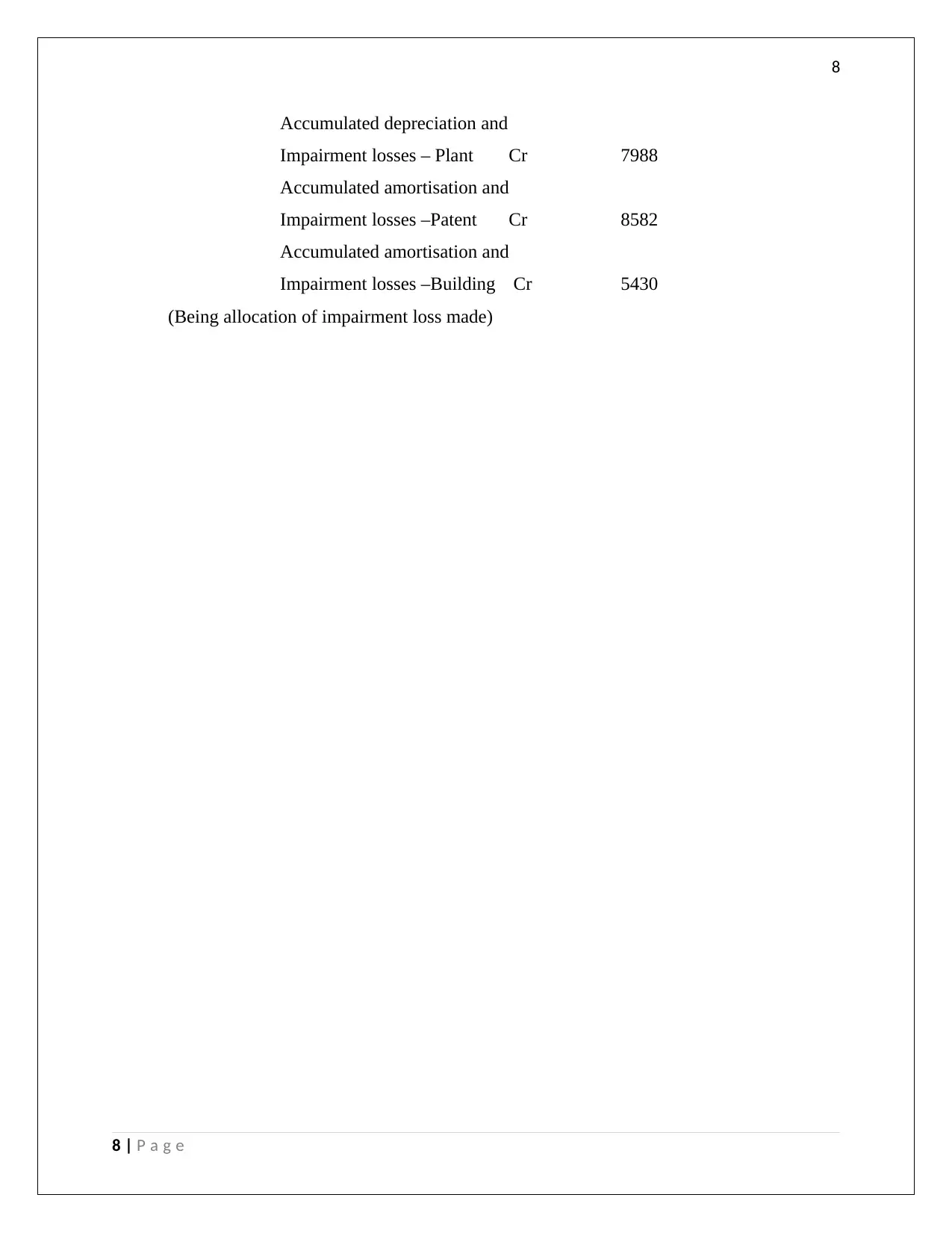
8
Accumulated depreciation and
Impairment losses – Plant Cr 7988
Accumulated amortisation and
Impairment losses –Patent Cr 8582
Accumulated amortisation and
Impairment losses –Building Cr 5430
(Being allocation of impairment loss made)
8 | P a g e
Accumulated depreciation and
Impairment losses – Plant Cr 7988
Accumulated amortisation and
Impairment losses –Patent Cr 8582
Accumulated amortisation and
Impairment losses –Building Cr 5430
(Being allocation of impairment loss made)
8 | P a g e
⊘ This is a preview!⊘
Do you want full access?
Subscribe today to unlock all pages.

Trusted by 1+ million students worldwide
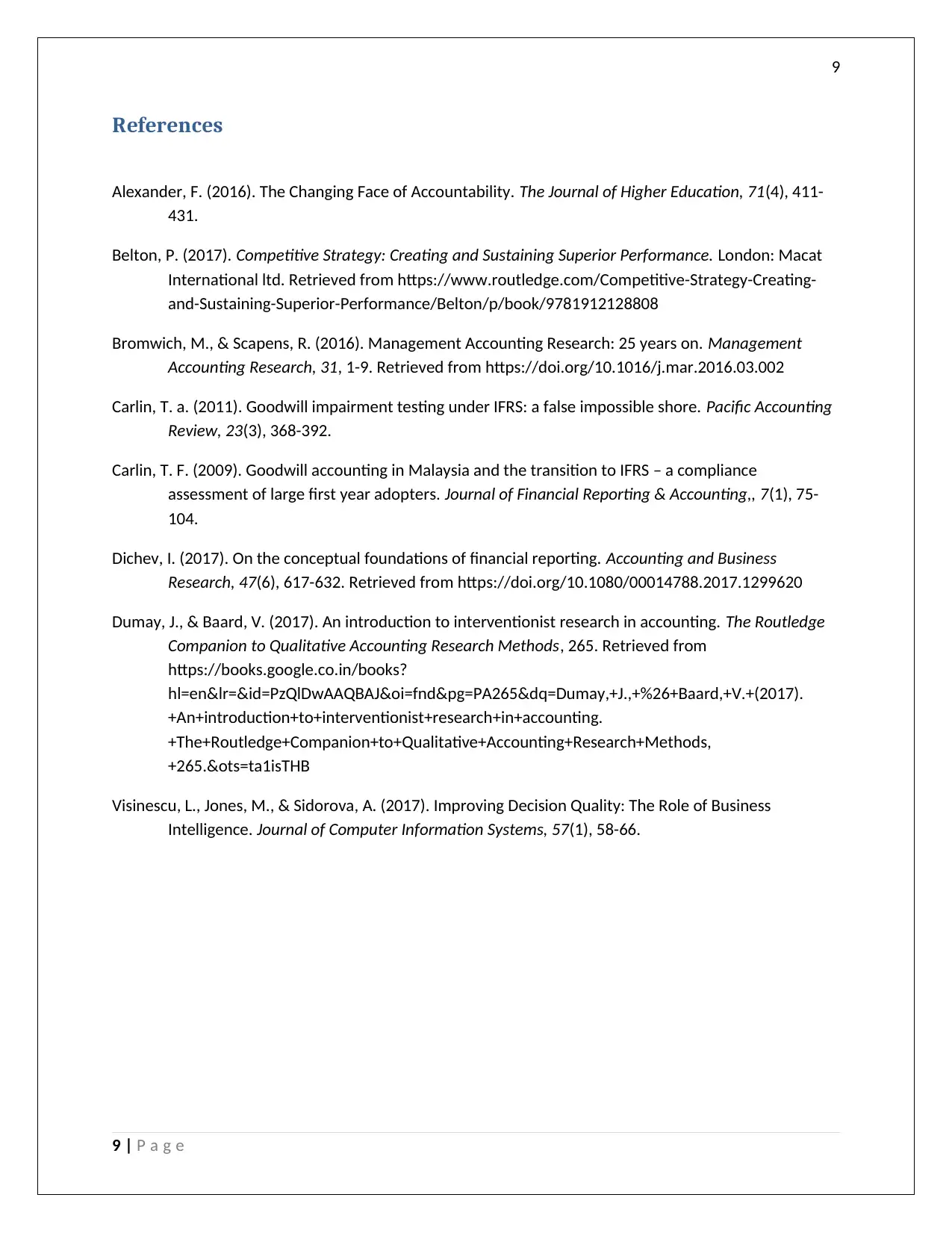
9
References
Alexander, F. (2016). The Changing Face of Accountability. The Journal of Higher Education, 71(4), 411-
431.
Belton, P. (2017). Competitive Strategy: Creating and Sustaining Superior Performance. London: Macat
International ltd. Retrieved from https://www.routledge.com/Competitive-Strategy-Creating-
and-Sustaining-Superior-Performance/Belton/p/book/9781912128808
Bromwich, M., & Scapens, R. (2016). Management Accounting Research: 25 years on. Management
Accounting Research, 31, 1-9. Retrieved from https://doi.org/10.1016/j.mar.2016.03.002
Carlin, T. a. (2011). Goodwill impairment testing under IFRS: a false impossible shore. Pacific Accounting
Review, 23(3), 368-392.
Carlin, T. F. (2009). Goodwill accounting in Malaysia and the transition to IFRS – a compliance
assessment of large first year adopters. Journal of Financial Reporting & Accounting,, 7(1), 75-
104.
Dichev, I. (2017). On the conceptual foundations of financial reporting. Accounting and Business
Research, 47(6), 617-632. Retrieved from https://doi.org/10.1080/00014788.2017.1299620
Dumay, J., & Baard, V. (2017). An introduction to interventionist research in accounting. The Routledge
Companion to Qualitative Accounting Research Methods, 265. Retrieved from
https://books.google.co.in/books?
hl=en&lr=&id=PzQlDwAAQBAJ&oi=fnd&pg=PA265&dq=Dumay,+J.,+%26+Baard,+V.+(2017).
+An+introduction+to+interventionist+research+in+accounting.
+The+Routledge+Companion+to+Qualitative+Accounting+Research+Methods,
+265.&ots=ta1isTHB
Visinescu, L., Jones, M., & Sidorova, A. (2017). Improving Decision Quality: The Role of Business
Intelligence. Journal of Computer Information Systems, 57(1), 58-66.
9 | P a g e
References
Alexander, F. (2016). The Changing Face of Accountability. The Journal of Higher Education, 71(4), 411-
431.
Belton, P. (2017). Competitive Strategy: Creating and Sustaining Superior Performance. London: Macat
International ltd. Retrieved from https://www.routledge.com/Competitive-Strategy-Creating-
and-Sustaining-Superior-Performance/Belton/p/book/9781912128808
Bromwich, M., & Scapens, R. (2016). Management Accounting Research: 25 years on. Management
Accounting Research, 31, 1-9. Retrieved from https://doi.org/10.1016/j.mar.2016.03.002
Carlin, T. a. (2011). Goodwill impairment testing under IFRS: a false impossible shore. Pacific Accounting
Review, 23(3), 368-392.
Carlin, T. F. (2009). Goodwill accounting in Malaysia and the transition to IFRS – a compliance
assessment of large first year adopters. Journal of Financial Reporting & Accounting,, 7(1), 75-
104.
Dichev, I. (2017). On the conceptual foundations of financial reporting. Accounting and Business
Research, 47(6), 617-632. Retrieved from https://doi.org/10.1080/00014788.2017.1299620
Dumay, J., & Baard, V. (2017). An introduction to interventionist research in accounting. The Routledge
Companion to Qualitative Accounting Research Methods, 265. Retrieved from
https://books.google.co.in/books?
hl=en&lr=&id=PzQlDwAAQBAJ&oi=fnd&pg=PA265&dq=Dumay,+J.,+%26+Baard,+V.+(2017).
+An+introduction+to+interventionist+research+in+accounting.
+The+Routledge+Companion+to+Qualitative+Accounting+Research+Methods,
+265.&ots=ta1isTHB
Visinescu, L., Jones, M., & Sidorova, A. (2017). Improving Decision Quality: The Role of Business
Intelligence. Journal of Computer Information Systems, 57(1), 58-66.
9 | P a g e
1 out of 10
Related Documents
Your All-in-One AI-Powered Toolkit for Academic Success.
+13062052269
info@desklib.com
Available 24*7 on WhatsApp / Email
![[object Object]](/_next/static/media/star-bottom.7253800d.svg)
Unlock your academic potential
Copyright © 2020–2025 A2Z Services. All Rights Reserved. Developed and managed by ZUCOL.



